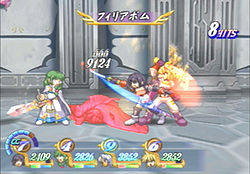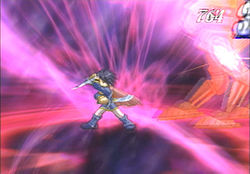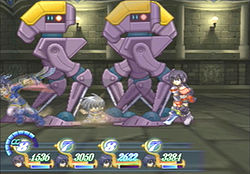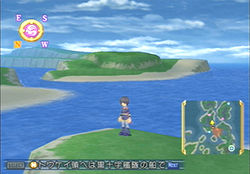.gif)
Tales of Destiny (PS2)
Encyclopedia
is a video game remake in the RPG genre published for the PlayStation 2
console by Namco Bandai Games
on November 30, 2006 in Japan
.
It is a remake of the second game in the Tales series, the original PlayStation
Tales of Destiny
, which was released on December 23, 1997.
Tales of Destiny (PS2)'s characteristic genre name is .
A Director's Cut
of the game with many new features and game modes was released on January 31, 2008 in Japan
.
. Later on November 15, 2006, one week before the original release date of November 22, 2006, the game was delayed to an unknown date. Two days later on November 17, 2006, the official Namco Tales site announced the release date of Tales of Destiny (PS2) would be pushed back to November 30, 2006, in order to fix a bug they discovered in the game during testing.

 The E-LMBS has been replaced by the new AR-LMBS (Aerial Linear Motion Battle System), a battle system that was built for aerial comboing, AR-LMBS replaces TP with the new Chain Capacity points. These CC points allow for easy comboing of any skills you like, provided you have the CC necessary.
The E-LMBS has been replaced by the new AR-LMBS (Aerial Linear Motion Battle System), a battle system that was built for aerial comboing, AR-LMBS replaces TP with the new Chain Capacity points. These CC points allow for easy comboing of any skills you like, provided you have the CC necessary.
Each character has a base and max CC, which can be changed using several methods. At the start of a battle, the character will start at their base CC. Every time they use up CC, it will go up 1 higher than before, until it has reached the character's max CC; from there, it will go down to the base CC again.
Some enemies can inflict you with a status effect called Downsize, this status effect will revert your character to their PS1 version sprite, you will be unable to attack while downsized, you can only walk (not run) or use items.

The main story for the game is completely voiced, like all the other PS2 Tales of games.
The remake features overhauled hand-drawn sprite-on-3D-background graphics similar to those of Tales of Rebirth
.
With the exception of Leon, all ten playable characters are available at the end of the game, whereas the original only allowed two extras (non Swordian-users) in the final areas. (This included Lilith if she had been recruited via use of the glitch or Gameshark.) Karyl and Bruiser join the party as part of the story in the remake. Lilith can also be recruited through a side-quest instead of a glitch or cheat, and her move Thunder Sword has now become her only Blast Caliber.
To get Lilith, talk to her in Lienea after you can freely control the sea dragon, and then defeat her in the coliseum at rank 4 with Stahn.
New scenes have been added, while some scenes from the original, such as the date with Ilene, were removed.
Several bosses have been removed/added, such as a certain pre-final boss fight being taken out. The boss order has been changed slightly as well. Also included is a new battle between Stahn Aileron and Dymlos, in an attempt to regain the full strength of the Swordians.
The game music has been remixed, and several new songs have been added in to the soundtrack.
The original's two main battle themes, Bare its Fangs and Surprise Attack!, have been made the main battle themes for the first and second halves of the game, respectively.
They are joined by a new third main battle theme toward the end called Progress Toward the End (another Bare its Fangs remix), which is the main battle theme at the very end of the game.
The skit system has been revamped.
 The world map is now in full 3D and even has some mini-games on it. There are also more vehicles than in the original.
The world map is now in full 3D and even has some mini-games on it. There are also more vehicles than in the original.
One of the most notorious new features is the featuring of one of Tales of Destiny 2
' s main antagonists Barbatos Goetia as a secret random encounter. He is usually found if the player attempts to 'auto-level' (running around in circles in the world map while setting all characters' controls to be Auto) and can be found even when the player's party is not greatly leveled, which can occasionally cause game overs. Barbatos is also an end boss in the game's secret dungeon.
Another feature present in this remake are the Narikiri dolls. When the player beats the game, he gains access to the EX Dungeon, a 10-floor bonus dungeon. The clown who lets the player into that dungeon will allow the player to exchange earned EX Points from the dungeon for items, such as the Narikiri dolls. The Narikiri dolls allow the player to change the characters into other characters by equipping them with a doll. This also allows the player to use Leon Magnus in the second half of the game, or use a party consisting of four of him, or any other character.
When the player first gains access to the dungeon, only Narikiri Leon will be available (for 1,000 EX Points), but new characters will be available after every cleared floor.

 A Director's Cut
A Director's Cut
of Tales of Destiny (PS2) was announced on July 20, 2007, and was released on January 31, 2008 in Japan
for the PlayStation 2
. Tales of Destiny Director's Cut's characteristic genre name is .
This version of the game includes a new game mode called "Leon's Side". Lion's Side makes Leon Magnus the main character
of the game instead of Tales of Destiny's normal main character, Stahn Aileron.
The original game mode from Tales of Destiny (PS2) is still available to play, under the new name "Stahn's Side".
There is also a very small sidequest in Stahn's Side, called "Lilith's Side", where Stahn's sister Lilith Aileron goes into the Tilso Forest to get herbs as a present for Stahn.
Lilith's Side can be started by sleeping in the Snowfreer Inn at the end of a Stahn's Side playthrough.
If the player uses a Holy Bottle to avoid any random battles, this sidequest is beatable in less than 5 minutes.
In addition to Lilith's Side, several other sidequests have been added.
Tales of Destiny (PS2) save files are still loadable in Tales of Destiny Director's Cut from the Load Original Data option on the game's title screen.
The game includes the "Second" difficulty rank that was available in Tales of Destiny 2
, this difficulty rank was not available in the original release of Tales of Destiny (PS2).
Several characters have received new skills, especially Lion Magnus, who also received a third Blast Caliber called Majinken Setsuga.
The Colosseum has a new Rank 6, that has many of the game's bosses appear in a boss rush, including the game's hardest enemy, Barbatos.
A Definite Mode was also added, which allows the player to choose from previously encountered enemies, and attempt to get their Definite Strikes, the enemies won't die until the player performs the Definite Strike, so doing infinite combos here is possible.
Two new end-game carry over features have been added, Succeed Skill, which transfers skills and spells over to the next playthrough, and Succeed Food Strap, which transfers the player's Food Strap to the next playthrough.
Max Stats have been increased from 999 to 1999, Max Lens have been increase from 990 to 9990, and Max HP has been increased to 9999.
There are also new Swordian Device skills, post battle voices, more skits, and the effects of some features that were abusable were lessened, such as Flash.
Tales of Destiny Director's Cut was released in two versions, the regular version, containing just the game, and a Premium Box version containing a special Premium Box with artwork by Mutsumi Inomata
, the game, a 128 page illustration booklet with character artwork by Mutsumi Inomata, and an original soundtrack of the Director's Cut (featuring 21 songs).
PlayStation 2
The PlayStation 2 is a sixth-generation video game console manufactured by Sony as part of the PlayStation series. Its development was announced in March 1999 and it was first released on March 4, 2000, in Japan...
console by Namco Bandai Games
Namco Bandai Games
is an arcade, mobile and home video game developer and publisher based in Japan which is the product of a merger between the video game development divisions of Bandai and Namco. Namco Bandai Games is a wholly owned subsidiary of Namco Bandai Holdings and specializes in production and sales of...
on November 30, 2006 in Japan
Japan
Japan is an island nation in East Asia. Located in the Pacific Ocean, it lies to the east of the Sea of Japan, China, North Korea, South Korea and Russia, stretching from the Sea of Okhotsk in the north to the East China Sea and Taiwan in the south...
.
It is a remake of the second game in the Tales series, the original PlayStation
PlayStation
The is a 32-bit fifth-generation video game console first released by Sony Computer Entertainment in Japan on December 3, .The PlayStation was the first of the PlayStation series of consoles and handheld game devices. The PlayStation 2 was the console's successor in 2000...
Tales of Destiny
Tales of Destiny
is a video game in the RPG genre published for the PlayStation console by Namco on December 23, 1997 in Japan, selling 1,139,000 copies. Tales of Destiny's characteristic genre name is...
, which was released on December 23, 1997.
Tales of Destiny (PS2)'s characteristic genre name is .
A Director's Cut
Director's cut
A director's cut is a specially edited version of a film, and less often TV series, music video, commercials, comic book or video games, that is supposed to represent the director's own approved edit...
of the game with many new features and game modes was released on January 31, 2008 in Japan
Japan
Japan is an island nation in East Asia. Located in the Pacific Ocean, it lies to the east of the Sea of Japan, China, North Korea, South Korea and Russia, stretching from the Sea of Okhotsk in the north to the East China Sea and Taiwan in the south...
.
History
On June 19, 2006, scans indicated that a remake of Tales of Destiny would appear on the PlayStation 2PlayStation 2
The PlayStation 2 is a sixth-generation video game console manufactured by Sony as part of the PlayStation series. Its development was announced in March 1999 and it was first released on March 4, 2000, in Japan...
. Later on November 15, 2006, one week before the original release date of November 22, 2006, the game was delayed to an unknown date. Two days later on November 17, 2006, the official Namco Tales site announced the release date of Tales of Destiny (PS2) would be pushed back to November 30, 2006, in order to fix a bug they discovered in the game during testing.
Battle system


Each character has a base and max CC, which can be changed using several methods. At the start of a battle, the character will start at their base CC. Every time they use up CC, it will go up 1 higher than before, until it has reached the character's max CC; from there, it will go down to the base CC again.
Some enemies can inflict you with a status effect called Downsize, this status effect will revert your character to their PS1 version sprite, you will be unable to attack while downsized, you can only walk (not run) or use items.

Changes from the original
Though the overall plot remains the same, the entire game script has been re-written.The main story for the game is completely voiced, like all the other PS2 Tales of games.
The remake features overhauled hand-drawn sprite-on-3D-background graphics similar to those of Tales of Rebirth
Tales of Rebirth
is the sixth mothership title in Namco's Tales RPG series. It was released on December 16, 2004 in Japan for the Sony PlayStation 2. Tales of Rebirth's characteristic genre name is . Tales of Rebirth has an anime introductory video accompanied by the song Good Night by Every Little Thing. Notably,...
.
With the exception of Leon, all ten playable characters are available at the end of the game, whereas the original only allowed two extras (non Swordian-users) in the final areas. (This included Lilith if she had been recruited via use of the glitch or Gameshark.) Karyl and Bruiser join the party as part of the story in the remake. Lilith can also be recruited through a side-quest instead of a glitch or cheat, and her move Thunder Sword has now become her only Blast Caliber.
To get Lilith, talk to her in Lienea after you can freely control the sea dragon, and then defeat her in the coliseum at rank 4 with Stahn.
New scenes have been added, while some scenes from the original, such as the date with Ilene, were removed.
Several bosses have been removed/added, such as a certain pre-final boss fight being taken out. The boss order has been changed slightly as well. Also included is a new battle between Stahn Aileron and Dymlos, in an attempt to regain the full strength of the Swordians.
The game music has been remixed, and several new songs have been added in to the soundtrack.
The original's two main battle themes, Bare its Fangs and Surprise Attack!, have been made the main battle themes for the first and second halves of the game, respectively.
They are joined by a new third main battle theme toward the end called Progress Toward the End (another Bare its Fangs remix), which is the main battle theme at the very end of the game.
The skit system has been revamped.

One of the most notorious new features is the featuring of one of Tales of Destiny 2
Tales of Destiny 2
is the fourth mothership title in Namco's popular Tales RPG series, a true sequel to Tales of Destiny that takes place in the same fictional world...
Another feature present in this remake are the Narikiri dolls. When the player beats the game, he gains access to the EX Dungeon, a 10-floor bonus dungeon. The clown who lets the player into that dungeon will allow the player to exchange earned EX Points from the dungeon for items, such as the Narikiri dolls. The Narikiri dolls allow the player to change the characters into other characters by equipping them with a doll. This also allows the player to use Leon Magnus in the second half of the game, or use a party consisting of four of him, or any other character.
When the player first gains access to the dungeon, only Narikiri Leon will be available (for 1,000 EX Points), but new characters will be available after every cleared floor.

Classic Namco references
- Players may acquire several items that references to Tales of Destiny 2Tales of Destiny 2is the fourth mothership title in Namco's popular Tales RPG series, a true sequel to Tales of Destiny that takes place in the same fictional world...
characters, such as a wig resembling Nanally's hair and a mask identical to Judas'. - Kratos Aurion replaces Cress and Arche as the Quiz Master.
- Dolls of Mieu and Tokunaga (Anise's doll) can be found in various houses.
- Pictures in Heidelberg Castle feature characters from Tales of RebirthTales of Rebirthis the sixth mothership title in Namco's Tales RPG series. It was released on December 16, 2004 in Japan for the Sony PlayStation 2. Tales of Rebirth's characteristic genre name is . Tales of Rebirth has an anime introductory video accompanied by the song Good Night by Every Little Thing. Notably,...
, Veigue Lungberg, Agarte Lindblum, and Annie Barrs. - A character resembling Veigue Lungberg appears as a boss in the EX Dungeon, using some very similar attacks.
- One of the shopkeepers of a bakery in Lienea resembles Mimmi Bread, the 'Wonder Chef' of Tales of LegendiaTales of Legendia, is a role-playing game that was developed and published by Namco for the PlayStation 2 video game console. It was released in Japan on August 25, 2005 and in the United States on February 7, 2006. Tales of Legendia's characteristic genre name is . It is the seventh mothership title in the Tales...
. - Mieu is also seen here from Tales of the AbyssTales of the Abyssis a console role-playing game developed by Namco Tales Studio and published by Namco in Japan and Namco Bandai Games in North America. Tales of the Abyss's characteristic genre name is The Meaning Of Birth RPG . It is the eighth mothership title in the Tales series, and was released for the...
. - During one of the cutscenes, Zapie from Tales of RebirthTales of Rebirthis the sixth mothership title in Namco's Tales RPG series. It was released on December 16, 2004 in Japan for the Sony PlayStation 2. Tales of Rebirth's characteristic genre name is . Tales of Rebirth has an anime introductory video accompanied by the song Good Night by Every Little Thing. Notably,...
can be seen sitting on top of a cabin roof. - Kyle from Tales of Destiny 2 appears as a doll in Mary's house during a sidequest. Loni can be seen as a kid in Cresta.
- Hats from several Tales of characters make appearances on Gentlemen as cameoCameo appearanceA cameo role or cameo appearance is a brief appearance of a known person in a work of the performing arts, such as plays, films, video games and television...
enemies in a sidequest. Gentlemen wearing the hats of Claus, Ras, Chloe, and Hilda (from Tales of PhantasiaTales of Phantasiais a Super Nintendo game in the RPG genre published by Namco and released in Japan in 1995, selling 212,000 copies. It is the first mothership title in the Tales RPG series and was later remade/re-released on the PlayStation, Game Boy Advance and PlayStation Portable...
, Tales of EterniaTales of Eterniais a Japanese PlayStation action role-playing video game released by Namco on November 30, 2000, selling 873,000 copies and later ported to the PlayStation Portable on March 3, 2005, selling 398,000 copies. Tales of Eternia's characteristic genre name is...
, Tales of LegendiaTales of Legendia, is a role-playing game that was developed and published by Namco for the PlayStation 2 video game console. It was released in Japan on August 25, 2005 and in the United States on February 7, 2006. Tales of Legendia's characteristic genre name is . It is the seventh mothership title in the Tales...
, and Tales of Rebirth respectively) can be fought individually, and later altogether during the same sidequest. - A Gentlemen wearing the hat of KOS-MOS from the XenosagaXenosagais a series of science fiction video games developed by Monolith Soft and published by Namco Bandai. Xenosaga's main story is in the form of a trilogy of PlayStation 2 video games. There have been three spin-off games and an anime adaptation. The Xenosaga series serves as a spiritual successor to...
series can be fought in the EX Dungeon; this Gentlemen has several of KOS-MOS' moves.
Director's Cut

Director's cut
A director's cut is a specially edited version of a film, and less often TV series, music video, commercials, comic book or video games, that is supposed to represent the director's own approved edit...
of Tales of Destiny (PS2) was announced on July 20, 2007, and was released on January 31, 2008 in Japan
Japan
Japan is an island nation in East Asia. Located in the Pacific Ocean, it lies to the east of the Sea of Japan, China, North Korea, South Korea and Russia, stretching from the Sea of Okhotsk in the north to the East China Sea and Taiwan in the south...
for the PlayStation 2
PlayStation 2
The PlayStation 2 is a sixth-generation video game console manufactured by Sony as part of the PlayStation series. Its development was announced in March 1999 and it was first released on March 4, 2000, in Japan...
. Tales of Destiny Director's Cut's characteristic genre name is .
This version of the game includes a new game mode called "Leon's Side". Lion's Side makes Leon Magnus the main character
Protagonist
A protagonist is the main character of a literary, theatrical, cinematic, or musical narrative, around whom the events of the narrative's plot revolve and with whom the audience is intended to most identify...
of the game instead of Tales of Destiny's normal main character, Stahn Aileron.
The original game mode from Tales of Destiny (PS2) is still available to play, under the new name "Stahn's Side".
There is also a very small sidequest in Stahn's Side, called "Lilith's Side", where Stahn's sister Lilith Aileron goes into the Tilso Forest to get herbs as a present for Stahn.
Lilith's Side can be started by sleeping in the Snowfreer Inn at the end of a Stahn's Side playthrough.
If the player uses a Holy Bottle to avoid any random battles, this sidequest is beatable in less than 5 minutes.
In addition to Lilith's Side, several other sidequests have been added.
Tales of Destiny (PS2) save files are still loadable in Tales of Destiny Director's Cut from the Load Original Data option on the game's title screen.
The game includes the "Second" difficulty rank that was available in Tales of Destiny 2
Tales of Destiny 2
is the fourth mothership title in Namco's popular Tales RPG series, a true sequel to Tales of Destiny that takes place in the same fictional world...
, this difficulty rank was not available in the original release of Tales of Destiny (PS2).
Several characters have received new skills, especially Lion Magnus, who also received a third Blast Caliber called Majinken Setsuga.
The Colosseum has a new Rank 6, that has many of the game's bosses appear in a boss rush, including the game's hardest enemy, Barbatos.
A Definite Mode was also added, which allows the player to choose from previously encountered enemies, and attempt to get their Definite Strikes, the enemies won't die until the player performs the Definite Strike, so doing infinite combos here is possible.
Two new end-game carry over features have been added, Succeed Skill, which transfers skills and spells over to the next playthrough, and Succeed Food Strap, which transfers the player's Food Strap to the next playthrough.
Max Stats have been increased from 999 to 1999, Max Lens have been increase from 990 to 9990, and Max HP has been increased to 9999.
There are also new Swordian Device skills, post battle voices, more skits, and the effects of some features that were abusable were lessened, such as Flash.
Tales of Destiny Director's Cut was released in two versions, the regular version, containing just the game, and a Premium Box version containing a special Premium Box with artwork by Mutsumi Inomata
Mutsumi Inomata
is a Japanese illustrator and animator.-Biography:An anime fan, Inomata began her career as an animator with Toei Animation, soon after graduating from her senior year at high school...
, the game, a 128 page illustration booklet with character artwork by Mutsumi Inomata, and an original soundtrack of the Director's Cut (featuring 21 songs).
External links
- Official Tales of Destiny (PS2) Website
- Official Tales of Destiny Director's Cut Website
- Official Tales of Destiny (PS2) Linkage Website (Service officially stopped on May 31, 2007, was originally supposed to run for 1 year, instead of a half year.)
- Tales of Destiny (PS2) Fan Translation Wiki

